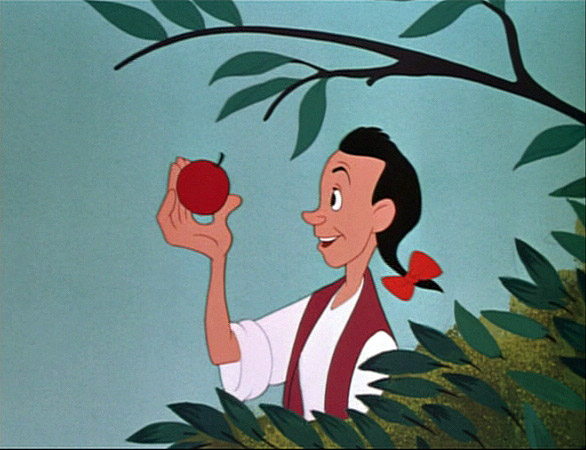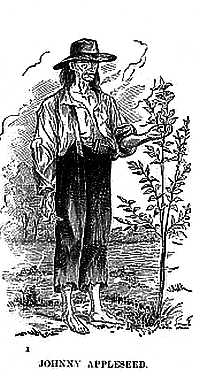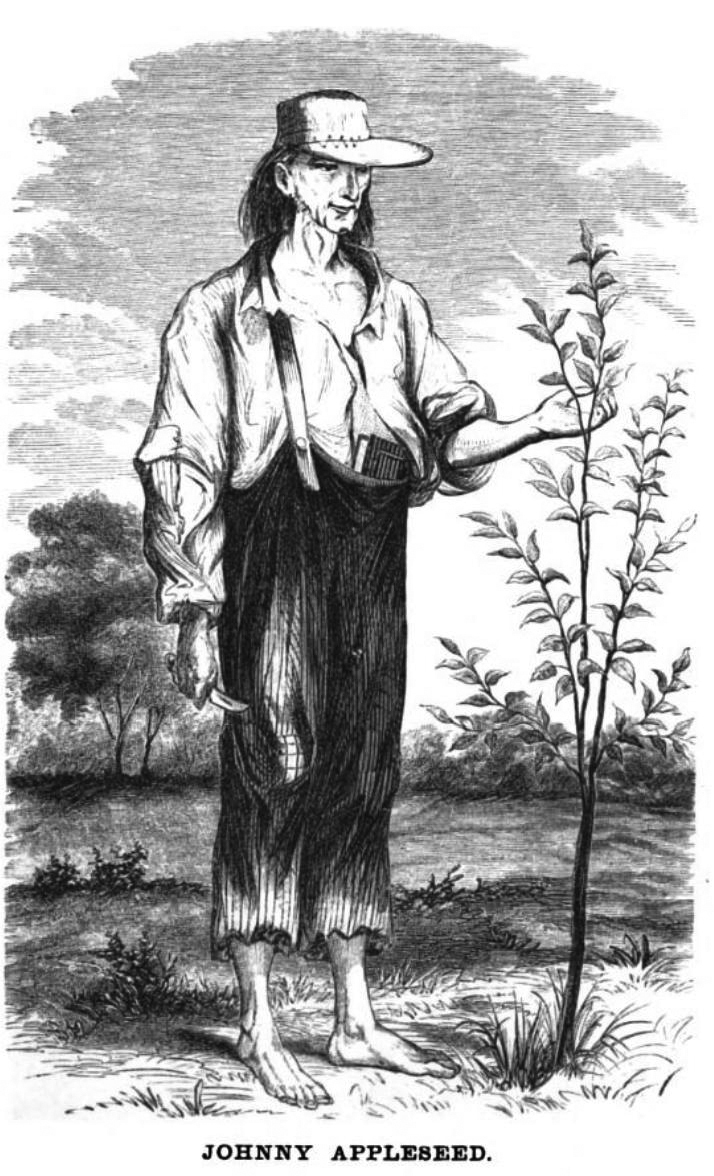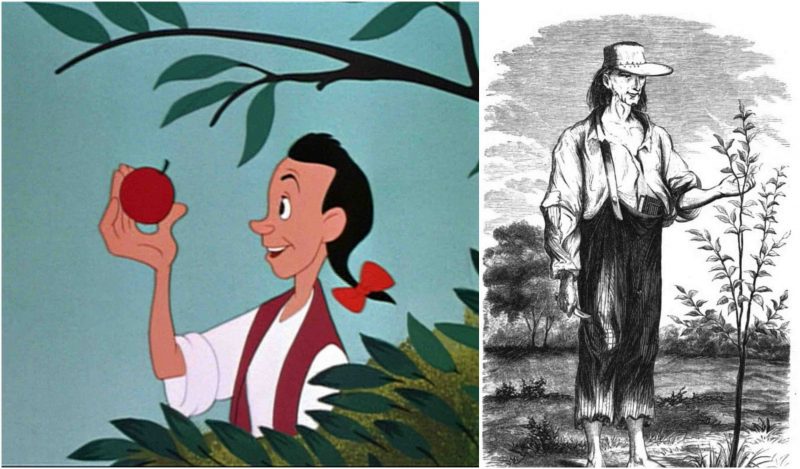There is a farm in Nova, Ohio on which a very special tree can be found. This is not an ordinary tree. It is believed that the 175-year-old tree is the last remaining evidence of John Chapman, a famous nurseryman.
During the early 1800s, he planted huge amounts of apple trees along the American western frontier (the western frontier was anything that lay beyond Pensylvania at that time).
Chapman is better known by his other name: Johnny Appleseed, and thanks to Disney, he was turned into a fairytale. One segment of the 1948 cartoon “Melody Time” depicts Johnny Appleseed as a happy wanderer planting and taking care of apples, protected by his old guardian angel.
All around him were birds flying and his apples were all perfect and red. This image is actually not exactly true, it is distorted by our perception of the apples as a sweet and tasty fruit. Chapman’s apples, the ones the he decided to plant on the frontier, were actually quite different, from the ones you find today on the market and they were not meant for eating. They were used for making apple cider, America’s most popular beverage at that time.

In the times before the prohibition, most of the apples that were grown usually ended up in a barrel of cider. In rural America, cider was a substitute for wine and beer, coffee and tea, and even for water. It was quite popular. Many people used to drink cider and not water because clean water was kind of a luxury back then.
For people on the frontier, it was healthier and safer to drink apple cider instead of water that was potentially infested with bacteria. Historical data shows that Englanders on the frontier used to drink 10.52 ounces of hard cider per day.
This is pretty high number compared to the amount of water that an average American drinks today (20 ounces per day). Cider was a necessity and it was a common part of the diet as much as meat or bread. We can see that the apples played a major role in the survival of the early Americans.
John Chapman was born on September 26, 1774, in Leominster, Massachusetts. Not much is known of his early life, but from what is known, at some point he parted ways with his family and started his apprenticeship as an orchardist under a certain Mr. Crawford, who had apple orchards.
This inspired what turned out to be his life journey, planting apple trees. In the early 1800’s Chapman’s name reappears in history, in Pittsburgh, Pennsylvania near America’s rapidly expanding Western frontier.
At the beginning of the 19-th century, companies started buying huge pieces of land in the Northwest Territory and encouraged settlers to come and work on the land.
For example, in 1792 the Ohio Company of Associates made a deal with any potential settler that: if he was willing to make a permanent homestead in the wild lands beyond Ohio’s first permanent settlement, he would be granted 100 acres of land. As proof of their willingness to stay there, they were required to plant 50 apple trees and 20 peach trees in the time period of 3 years. This was required because it took about 10 years for an apple tree to give its first fruits.

Chapman realized the potential of the situation. He came to the idea that he could do the hard work of planting the orchards instead of the frontiersmen and then sell them to the potential settlers for profit. A brilliant idea! Chapman started wandering into the unknown lands one step ahead of the settlers and planted apples on his way. After cultivating and selling a piece of land, he continued further into undeveloped areas. He literary carried a bag of apple seeds and “paved” the land with apple trees.
Chapman was a member of the Swedenborgian Church. Thir belief system was forbidding grafting because they believed that this made plants to suffer. That is why Chapman used seeds for every apple he planted. This means that most parts of his apples were not really edible (because of the biology of this plant).
Chapman and the other early Americans were aware of grafting, but they didn’t bother with it because the apples for them were not useful and profitable for eating as much as for making cider, the “ambrosia” od the frontiersmen.
Johnny Appleseed died in 1845 with almost no land of his own. He was described by the newspapers as “an eccentric individual, he sauntered through town eating his dry crust and cold meat, and freely conversing on the mysteries of his religious faith. He was a devoted follower of Emanuel Swedenborg, and notwithstanding his apparent poverty, was reputed to be in good circumstances.”
Appleseed left a huge legacy, although he didn’t keep any material wealth for himself. He was a huge benefactor. He left an estate of over 1,200 acres (490 ha) of valuable nurseries to his sister. He also owned four plots in Allen County, Indiana, including a nursery in Milan Township, with 15,000 trees. He bought the southwest quarter (160 acres) of section 26, Mohican Township, Ashland County, Ohio, but he did not record the deed and lost the property.

During the prohibition time, FBI agents used to chop down every apple tree that produced sour and bitter apples used for cider. Because of this, many of the orchards that Appleseed planted do not survive today, but that doesn’t make his effort forgotten and useless. Because of his work, today we can enjoy some tasty apple varieties as the delicious, the golden delicious and many more.
His choice of cultivating apple trees by seed gave the strong roots for the creation of the great American apple. The unpredictable apple seeds gave the opportunity to experiment with different apple properties and choose the perfect combination that will be ideal for the New World.
The geographic origin of the apple can be traced to modern-day Kazakhstan but the Romans are the ones that popularized it the most. They sophisticated the skill of apple grafting. Grafting is crucial for producing apples. The apple seed is very unpredictable. If you plant a seed from a golden delicious apple that doesn’t mean that it will produce the same apple, maybe there will be similarities but they will never be the same.
This characteristic of apple seeds is known as “extreme heterozygotes” in biology. That is why most of the seed-grown apples were inedible and used to be called “spitters” because that is your first reaction after tasting the fruit.
However, today we remember that Chapman Disney showed us the jolly wanderer that picks tasty red apples in his basket. In the meantime, cider is slowly getting back on the American market. It is considered to be the fastest growing alcoholic beverage in America.
